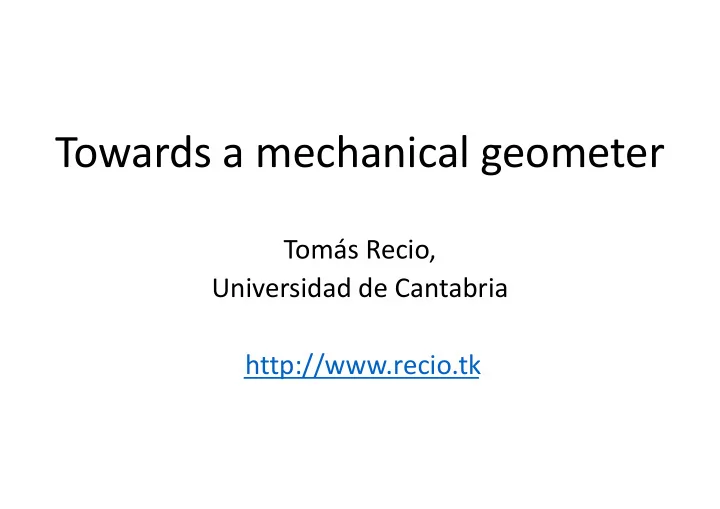

Towards a mechanical geometer Tomás Recio, Universidad de Cantabria http://www.recio.tk
Abstract: I will report on recent work on the automated discovery of properties in elementary geometry. A prototype system is being currently implemented on top of GeoGebra. The method for discovering new results from a given construction is symbolic, providing them with mathematical rigor and certainty. After describing some generalities about the “mechanical geometer” I will end reflecting on some of the many challenges and applications it poses, in the educational system and beyond.
Team • Francisco Botana • Zoltán Kovács • Philippe R. Richard • M. Pilar Vélez • Steven van Vaerenbergh Et al. : Abánades, Solyom-Gecse, Vajda, Sendra, Villarino, Martínez-Sevilla…
Howson, G. and Wilson, B. (1986): ICMI Study series: Scho hool mathe hematics in n the he 1990’s . Kuwait: Cambridge University Press. “…even if the students will not have to deal with computers till they leave school, it will be necessary to rethink the curriculum, because of the changes in interests that computer have brought”
Algorithms, Combinatorics? vs AI, Machine Learning? • Geometric Calculator… • Interestingness, Geometrography, Complexity,….
Didactical Issues: the role of reasoning and proving As an auxiliary tool, what opportunities, what differences involve using GeoGebra ART? • Can guide student exploration, provide hints, answer (partially) questions… • Can help building up diagrams, locus… • Helping teachers!
• Math proofs: an identity feature. • …but, what if the output of reasoning can be automatically obtained? • We can teach neither as nor the mathematics of the past…. • Not, particularly, in the case of Euclidean geometry, which is so much tool driven •The message is clear: classical proof must move over… The Rise, Fall, and Possible Transfiguration of Triangle Geometry: A Mini- History, Philip J. Davis. The American Mathematical Monthly , Vol. 102, No. 3. (Mar., 1995), pp. 204-214 .
>>> From doing things better to doing better things? • Gelernter, H. (1959): Realization of a geometry theorem proving machine. Proc. Int. Conf. on Information Processing. Paris, UNESCO house. pp. 273-282. • QED Manifesto (1994): “QED is … a project to build a computer system that effectively represents all important mathematical knowledge and techniques. ” https://www.cs.ru.nl/~freek/qed/qed.html, https://en.wikipedia.org/wiki/QED_manifesto
• https://www.researchgate.net/profile/Tomas_Recio • X.Chen, D. Wang: Towards an electronic geometry textbook. In: Automated Deduction in Geometry (F. Botana and T. Recio, eds.), Lecture Notes in Artificial Intelligence 4869, pp. 1–23. Springer, Berlin Heidelberg, 2007. • P. R. Richard; J.M. Fortuny,; M. Hohenwarter, M. Gagnon : geogebraTUTOR : une nouvelle approche pour la recherche sur l’apprentissage compétentiel et instrumenté de la géométrie à l’école secondaire. In T. Bastiaens & S. Carliner (Eds.), Proceedings of E-Learn 2007--World Conference on E- Learning in Corporate, Government, Healthcare, and Higher Education (pp. 428-435). Quebec City, Canada: Association for the Advancement of Computing in Education (AACE). • J. Davenport, J. Fleuriot, P. Quaresma, T. Recio, D. Wang: Intelligent Geometry Tools, Proc. Second International Workshop on Automated Reasoning: Challenges, Applications, Directions, Exemplary Achievements, Natal, Brazil, August 26, 2019, EPTCS 311, Towards a COST Network proposal!
www.math.rutgers.edu/~zeilberg/PG/gt.html
Recommend
More recommend